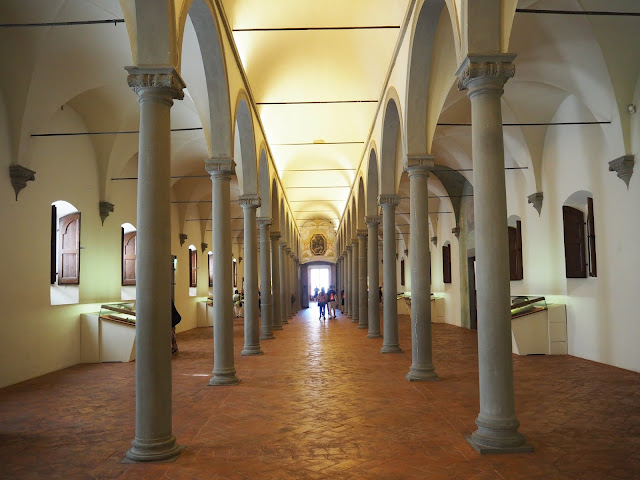【フィレンツェ】サン・マルコ美術館とフィチーノ Firenze - Museo di San Mrco & Marsilio Ficino
サン・マルコ美術館の2階には、図書室と呼ばれる長細い部屋がある。
現在は、とても図書室には見えないが、かつてここは近世ヨーロッパで最初の公共図書館だった。
この修道院を建てたコジモ・デ・メディチは、友人のニッコロ・ニッコリが収集していた600冊の蔵書を市民に公開するために、修道院の一部にこの図書館を作った。
その蔵書の管理を任されたトマーゾ・パレントゥチェッリは、後にローマ教皇ニコラウス5世になり、ヴァチカン図書館の創設に関わることにもなった。
On the second floor of the San Marco Museum, there is a long and narrow room called the library.
It doesn't look like a library now, but it was once the first public library in early modern Europe.
Cosimo de'Medici, who built the monastery, built the library in a part of the monastery to open to the public the 600 books collected by his friend Niccolo Niccoli.
Tomazo Parentucelli, who was in charge of managing the collection, later became Pope Nicholas V and was involved in the founding of the Vatican Library.
現在、この図書室には、美しい挿絵が描かれた楽譜が展示されている。フラ・アンジェリコやその弟子たちが、こうした美しい挿絵を描いたという。
しかしかつては、この場所には、アリストテレス、プトレマイオス、プルタルコス、ウェルギリウス、キケロ、セネカなどの古代ギリシャ・ローマの古典が並んでいた。
サン・マルコ修道院には、そうした書物を読むために多くの人が訪れて、その内容について熱い議論が行われていた。
そうした人の中に、マルシリオ・フィチーがいた。
Currently, in this library, scores with beautiful illustrations are on display. Fra Angelico and his disciples are said to have painted these beautiful illustrations.
But in the past, this place was lined with ancient Greek and Roman classics such as Aristotle, Ptolemy, Plutarch, Virgil, Cicero and Seneca.
Many people visited the San Marco Monastery to read such books, and there was a heated debate about their contents.
Among those people was Marsilio Ficino.
サン・マルコ美術館の2階には、有名な受胎告知の他にも、多くのフラ・アンジェリコのフレスコ画がその壁に描かれている。
フィチーノは、コジモ・デ・メディチの主治医だった人物の子として、1433年にフィレンツェの郊外で生まれた。
幼い頃からその才能をコジモに見出されて、生活を全て援助されて、ギリシャ語やラテン語を学んでいた。
おそらくは、この図書館にも足繁く通い、多くの書物を読みこなしていたのだろう。
On the second floor of the San Marco Museum, in addition to the famous Annunciation, many Fra Angelico frescoes are painted on the wall.
Ficino was born in 1433 on the outskirts of Florence, the son of a man who was the attending physician of Cosimo de'Medici.
From an early age he discovered his talent in Cosimo and helped him with all his life, learning Greek and Latin.
He probably went to this library frequently and read a lot of books.
サン・マルコ美術館の2階は、前のページで紹介したサヴォナローラの僧坊を含めて、43の小さな僧坊が並んでいる。それぞれの部屋には、フラ・アンジェリコが描いたフレスコ画が描かれている。
コジモは、フィレンツェの郊外に別荘を建てて、そこにプラトン・アカデミーという研究機関を置いた。
フィチーノはそのアカデミーの主導的な役割を任されて、ヘルメス文書や、プラトンの書籍の翻訳を精力的に行なっていった。
The second floor of the San Marco Museum is lined with 43 small monks, including the Savonarola monk introduced on the previous page. Each room has a fresco by Fra Angelico.
Cosimo built a villa on the outskirts of Florence, where he set up a research institute called the Platonic Academy.
Ficino was given the lead role in the academy, energetically translating Hermetica and Plato's books.
僧院の中には、ロープが引かれていて、奥の方にまでは入れないが、中にある絵を見ることはできる。描かれているのは、新約聖書に書かれているキリストの生涯にまつわる様々なエピソードだ。
1439年にフィレンツェで行われた公会議に訪れた東ローマ帝国の人々がプラトンの著作を持ち込んだ。
その後のコンスタンチノープルの崩壊で、多くの人がイタリアに逃れてきたが、その中にいた学者たちも、プラトンの著作や新プラトン主義の著作を携えてきたのだろう。
フィチーノは、キリスト教とそうした新プラトン主義の思想を独自に解釈して、『プラトン神学』などの著作を次々に書き上げていった。
Inside the monastery, a rope is pulled and you can't go deep inside, but you can see the picture inside. Depicted are various episodes of Christ's life in the New Testament.
People of the Byzantine Empire who visited the Council in Florence in 1439 brought in Plato's writings.
With the subsequent collapse of Constantinople, many fled to Italy, but the scholars among them may have carried Plato's writings and Neoplatonist writings.
Ficino independently interpreted Christianity and such Neoplatonist ideas, and wrote one after another, such as "Plato Theology."
フラ・アンジェリコの『最後の晩餐』。キリストが十二使徒の一人一人に自分の体の象徴としてパンを与えている。
フィチーノは、人間は神につながる知性と動物につながる肉体や感覚を持っているが、自らの知性と理性を磨いて、神の存在に近づくことができる、という思想を持っていた。
フィチーノの思想は、占星術や自然魔術にも及び、当時のフィレンツェの知識階級や芸術家たちに大きな影響を与えた。
ボッティチェリもその一人だが、ウフィツィ美術館を訪れた際に、より詳しく触れるようにしよう。
Fra Angelico's "The Last Supper". Christ gives each of the Twelve Apostles bread as a symbol of his body.
Ficino had the idea that humans have an intellect that connects to God and a body and sensation that connects to animals, but that he can hone his intellect and reason to approach the existence of God.
Ficino's ideas extended to astrology and natural magic, and had a great influence on the intellectual class and artists of Florence at that time.
Botticelli is one of them, but he will go into more detail when he visits the Uffizi Gallery.
フラ・アンジェリコの『キリストの捕縛』。裏切り者ユダが、誰がキリストかどうかを伝えるためにキスをしようとしている場面。
1492年にロレンツォ・デ・メディチが亡くなり、フィチーノはパトロンを失った。
1498年にサヴォナローラが処刑された後、ローマ教会に対してサヴォナローラは反キリスト教的な存在だったという弁明書のようなものを書いている。
そしてその翌年、1499年の10月1日に63年の生涯をひっそりと閉じた。
科学的な思考が発展していったその後のヨーロッパにおいて、魔術的な要素の多いフィチーノの思想は次第に忘れられていった。
現在のサン・マルコ美術館、かつてのサン・マルコ修道院と図書館において、少しでもフィチーノの面影を探そうとするすためには、何らかの秘儀が必要なのかもしれない。
Fra Angelico's "Arrest of Christ". A scene where the traitor Judas is trying to kiss to tell who is Christ.
Lorenzo de'Medici died in 1492, and Ficino lost his patronage.
After Savonarola was executed in 1498, he wrote something like a defense to the Roman Church that Savonarola was an anti-Christian being.
The following year, on October 1, 1499, he quietly closed his 63-year life.
In Europe after the development of scientific thinking, Ficino's ideas with many magical elements were gradually forgotten.
At the current San Marco Museum, the former San Marco Monastery and Library, some mystery may be needed to try to find the vestiges of Ficino.
(Translated by Google Translate)









コメント
コメントを投稿